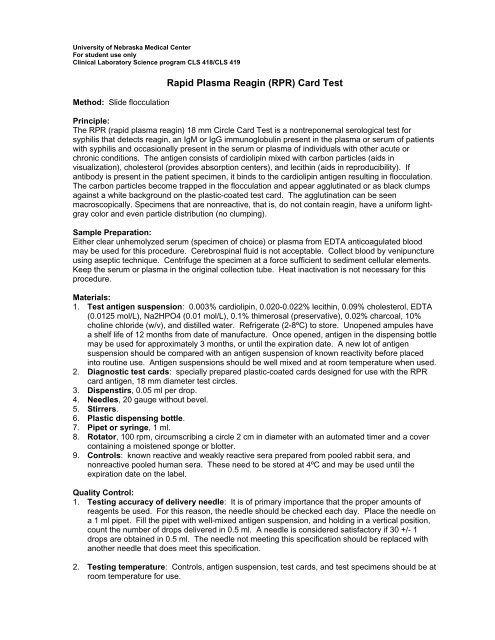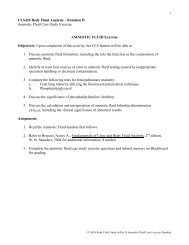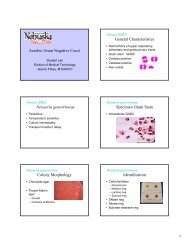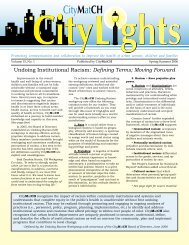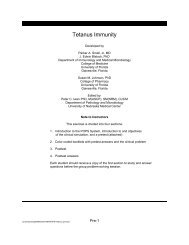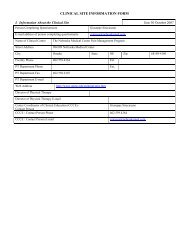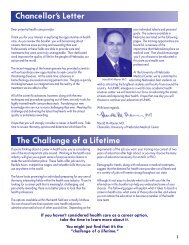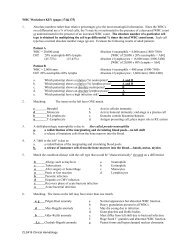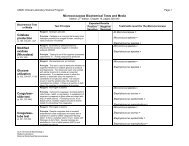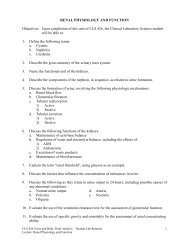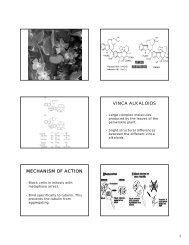Rapid Plasma Reagin (RPR) Card Test - UNMC
Rapid Plasma Reagin (RPR) Card Test - UNMC
Rapid Plasma Reagin (RPR) Card Test - UNMC
You also want an ePaper? Increase the reach of your titles
YUMPU automatically turns print PDFs into web optimized ePapers that Google loves.
University of Nebraska Medical Center<br />
For student use only<br />
Clinical Laboratory Science program CLS 418/CLS 419<br />
Method: Slide flocculation<br />
<strong>Rapid</strong> <strong>Plasma</strong> <strong>Reagin</strong> (<strong>RPR</strong>) <strong>Card</strong> <strong>Test</strong><br />
Principle:<br />
The <strong>RPR</strong> (rapid plasma reagin) 18 mm Circle <strong>Card</strong> <strong>Test</strong> is a nontreponemal serological test for<br />
syphilis that detects reagin, an IgM or IgG immunoglobulin present in the plasma or serum of patients<br />
with syphilis and occasionally present in the serum or plasma of individuals with other acute or<br />
chronic conditions. The antigen consists of cardiolipin mixed with carbon particles (aids in<br />
visualization), cholesterol (provides absorption centers), and lecithin (aids in reproducibility). If<br />
antibody is present in the patient specimen, it binds to the cardiolipin antigen resulting in flocculation.<br />
The carbon particles become trapped in the flocculation and appear agglutinated or as black clumps<br />
against a white background on the plastic-coated test card. The agglutination can be seen<br />
macroscopically. Specimens that are nonreactive, that is, do not contain reagin, have a uniform lightgray<br />
color and even particle distribution (no clumping).<br />
Sample Preparation:<br />
Either clear unhemolyzed serum (specimen of choice) or plasma from EDTA anticoagulated blood<br />
may be used for this procedure. Cerebrospinal fluid is not acceptable. Collect blood by venipuncture<br />
using aseptic technique. Centrifuge the specimen at a force sufficient to sediment cellular elements.<br />
Keep the serum or plasma in the original collection tube. Heat inactivation is not necessary for this<br />
procedure.<br />
Materials:<br />
1. <strong>Test</strong> antigen suspension: 0.003% cardiolipin, 0.020-0.022% lecithin, 0.09% cholesterol, EDTA<br />
(0.0125 mol/L), Na2HPO4 (0.01 mol/L), 0.1% thimerosal (preservative), 0.02% charcoal, 10%<br />
choline chloride (w/v), and distilled water. Refrigerate (2-8ºC) to store. Unopened ampules have<br />
a shelf life of 12 months from date of manufacture. Once opened, antigen in the dispensing bottle<br />
may be used for approximately 3 months, or until the expiration date. A new lot of antigen<br />
suspension should be compared with an antigen suspension of known reactivity before placed<br />
into routine use. Antigen suspensions should be well mixed and at room temperature when used.<br />
2. Diagnostic test cards: specially prepared plastic-coated cards designed for use with the <strong>RPR</strong><br />
card antigen, 18 mm diameter test circles.<br />
3. Dispenstirs, 0.05 ml per drop.<br />
4. Needles, 20 gauge without bevel.<br />
5. Stirrers.<br />
6. Plastic dispensing bottle.<br />
7. Pipet or syringe, 1 ml.<br />
8. Rotator, 100 rpm, circumscribing a circle 2 cm in diameter with an automated timer and a cover<br />
containing a moistened sponge or blotter.<br />
9. Controls: known reactive and weakly reactive sera prepared from pooled rabbit sera, and<br />
nonreactive pooled human sera. These need to be stored at 4ºC and may be used until the<br />
expiration date on the label.<br />
Quality Control:<br />
1. <strong>Test</strong>ing accuracy of delivery needle: It is of primary importance that the proper amounts of<br />
reagents be used. For this reason, the needle should be checked each day. Place the needle on<br />
a 1 ml pipet. Fill the pipet with well-mixed antigen suspension, and holding in a vertical position,<br />
count the number of drops delivered in 0.5 ml. A needle is considered satisfactory if 30 +/- 1<br />
drops are obtained in 0.5 ml. The needle not meeting this specification should be replaced with<br />
another needle that does meet this specification.<br />
2. <strong>Test</strong>ing temperature: Controls, antigen suspension, test cards, and test specimens should be at<br />
room temperature for use.
3. Rotator speed: Rotator must be checked daily for a proper rotation speed of 100 +/- 2 rpm.<br />
4. Controls: <strong>Test</strong> control sera of graded reactivity daily. Always include nonreactive, weakly<br />
reactive and reactive controls. In testing patient samples, use only those antigen suspensions<br />
that have given the appropriate reactions with the controls.<br />
Procedure:<br />
1. Hold a Dispenstir device between the thumb and forefinger near the sealed end. Squeeze and<br />
do not release until open end is below surface of the specimen. Hold specimen tube vertically to<br />
minimize stirring up of cellular elements when suing original blood tube. Release finger pressure<br />
to draw up the sample. Hold Dispenstir in a vertical position over the card test area (18 mm<br />
circle). Do not touch the surface of the card. Squeeze Dispenstir, allowing one drop (0.05 ml) of<br />
serum to fall onto card.<br />
2. Spread serum with inverted Dispenstir (closed end) or a stirrer (broad end) to fill the entire circle.<br />
Discard Dispenstir.<br />
3. Hydrate the lyophilized controls with a drop of distilled water using a Dispenstir. Spread each<br />
control with its own inverted Dispenstir or a stirrer to fill the entire circle. Discard Dispenstir.<br />
4. Attach the needle to the tapered fitting on the dispensing bottle that contains the antigen<br />
suspension. Gently shake antigen-dispensing bottle before use. Hold in a vertical position, and<br />
dispense several drops into bottle cap to make sure the needle passage is clear. Place 1 freefalling<br />
drop onto each test or control area. Return test droplets from the bottle cap to the<br />
dispensing bottle. Do not mix antigen and specimen. Mixing is accomplished during rotation.<br />
5. Place card on rotator and cover with a humidifier cover.<br />
6. Rotate 8 minutes at 100 rpm.<br />
7. Immediately following rotation, briefly rotate by hand with tilting of the card (3-4 to-and-fro<br />
motions). Read macroscopically in the “wet” state under a high-intensity incandescent lamp or<br />
strong daylight.<br />
8. Report as follows:<br />
Reactive –clumping, ranging from slight but definitive to marked and intense<br />
Nonreactive – slight roughness or no clumping<br />
NOTE: Specimens giving any degree of clumping should be subjected to further serologic<br />
study. The <strong>RPR</strong> test may be falsely positive in a number of situations. Any reactive serum<br />
should be tested by a treponemal specific test.<br />
9. Upon completion of tests, remove the needle from the dispensing bottle and rinse with distilled or<br />
deionized water. Do not wipe the needle, as this may remove the silicon coating and affect<br />
accuracy of delivery. Recap dispensing bottle and store in refrigerator.<br />
Reference Range:<br />
Normal healthy individuals should be nonreactive.<br />
References:<br />
1. Manual of tests for syphilis, PHS Publication No. 411, 1969.<br />
2. Stevens, C.D. (1996): Clinical Immunology and Serology, F.A. Davis, pages 246-247.<br />
3. Macro-Vue <strong>RPR</strong> 18-mm circle <strong>Card</strong> <strong>Test</strong> (Brewer Diagnostic Kit) package insert, Becton<br />
Dickinson and Company, Cockneysville, MD.


